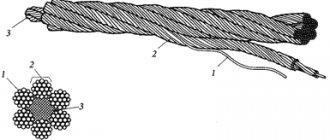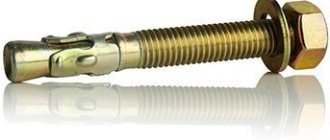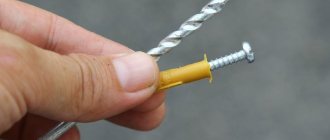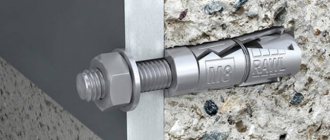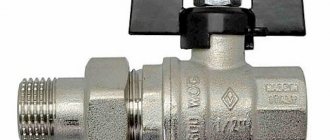The manufacture of rope slings involves the use of several methods for sealing the ends of the rope. Most often, manufacturers use the simplest methods, which involve the use of braiding and crimping using a special bushing.
| Connection type | Example | Rope diameter | Efficiency factor |
| U-clamps | All | 0.8 | |
| Aluminum bushing Steel bushing | All | 0.9 | |
| Hand Braid | ≤ 60 | 0.8 | |
| Filled coupling | All | 1 | |
| Pressing steel fittings | All | 0.9 | |
| Wedge ≤ N/mm2 < N/mm2 | All | 0.85 0.80 |
Methods of fastening steel ropes
The main requirement for fastening ropes is that it must be fixed in such a way that there is no risk of it falling off a winch, block or other support, as well as chafing due to contact with parts of structures. Depending on the application, there are different methods for securing cables.
There are the following methods of fastening crane ropes:
- Fastening to the main branch of the free end with a braid, or using a cable clamp. At the end of the cable, a loop with a thimble is formed.
- In a steel bushing (cast, forged, stamped) with a wedge or by filling with a light alloy (lead, zinc, babbitt).
- The winches are provided with special fastenings. In addition, fixation occurs using a wedge in a conical socket, using a clamping bar on the end surface of the flange.
2.12.Types of seals:
Coupler for casting steel rope
| Step 1 | Step2 | Step3 |
A method of embedding a steel rope into a coupling for filling with a low-melting alloy or polymer.
Wedge clamp.
Method of embedding a steel rope into a wedge coupling
Coupling for crimping steel rope
| Open | Closed |
Types of steel couplings for crimping steel rope
Fastening the rope to the drum
The method of fixing the rope to the winch must be provided for by the design of the mechanism itself. It must provide a sufficient level of fastening reliability.
The cable is laid on drums with flanges (sides to prevent slipping) in one or several layers:
- single layer;
- multilayer winding.
The edges of the ropes are attached to the surface:
- Wedge clamps are a type of clamping element where the workpiece is secured by a simple wedge, they are used to increase or change the direction of the clamping force. They are used on lifting mechanisms when frequent replacement of cables is necessary.
- clamping bars - devices for fixing cables by pressing them to a surface, usually clamped using nuts, bolts or other threaded elements.
The most common method of fixation on winches is using clamping bars.
Unboxing Features
Along with purchasing a piece of rope of the required length, you must be provided with documents for it. The certified certificate contains complete information about the structure of the product, load capacity and other parameters.
Next, you need to check that the packaging is correct. It is best when the cable is wound onto a reel. This packaging method minimizes the risk of damage to the rope during transportation.
If the footage is too small to be wound onto a drum, the steel sling is wound into a coil. With additional packaging in polyethylene, the bay also allows you to safely transport the product. You may need a special device to unpack correctly. Unwinding a cable from a fixed coil may be accompanied by the formation of kinks, bends, and loops.
It is forbidden to pull the sling along the ground, as abrasive particles, dirt, and dust may stick to the lubricant with which it is treated. When packing the cable into a coil and there is no device for unwinding, the product must be stretched to its full length on a clean surface.
Fastening the ends of the ropes to the axle
If it is necessary to secure the edges of the cable to the axle, thimbles are widely used. This is a forged, cast or stamped ring with a grooved section. The thimble protects against sharp bends and creases, reduces crushing stress and protects against abrasion on the axle. The cable is placed in the groove of the device and the free edge is connected to the main branch.
Fixation methods include:
- weaving;
- using shaped strips;
- using strips with trapezoidal grooves;
- fill;
- wedge
Weaving the wires of rope strands and then braiding them is considered a too labor-intensive method. Options with clamping devices are more common.
Tips for choosing
Before choosing a specific product, you need to make sure of its quality. To do this, you should pay attention to the following points:
- the clamps must be legibly marked;
- there should be no visible burrs, cracks, grooves or other manufacturing defects on the surface;
- clamps must be selected in accordance with the characteristics of the cables used;
- The type of material/coating of the clamp must correspond to the external factors and conditions in which the work is performed.
All of these types of rope clamps are designed and manufactured to order by GPO-Snab. You can select and order them in our catalog of rigging products.
Fastening the rope with clamps
There are many designs of clamping fixtures.
L-shaped devices are considered the simplest. They are two bent bolts. U-shaped devices consist of a clamp in the shape of the Latin letter U, the edges of which are threaded. The nuts clamp the bar, pressing the connection. Gear-shaped products are designed to prevent the nuts from self-loosening.
The pitch between the clamping devices and the length of the free edge from the latter should not be less than six cable diameters.
Types of fasteners and their designs
Jute products can be connected both temporarily and for a long period. In both cases, different fastenings of the rope ends are used. The operating principle of these devices is extremely simple. The main task of the mechanism is to prevent the possibility of cable slipping.
Clamps
This option is the most common and easiest to install. Such clamps consist mainly of two elements - pressing and adjustable.
U-clamp
Perhaps the simplest type of connection. To implement, you will need a U-shaped bracket and a special strip. Such fastenings are used even on heavy-duty cranes. The tightening is adjusted by nuts that are screwed onto the edges of the bracket. The undeniable advantage of this mechanism is the strength and durability of the connection.
Flat cable clamp
To install this sample, you will need a pair of plates. The parts are designed to compress the two sides of the rope, preventing it from slipping under serious load. Direct fixation is carried out in many cases with bolts. The clamp nuts tighten the cable, which remains motionless even under critical overloads. The clamping bars may have a corrugated surface on one side.
Attaching the safety rope
A safety rope is a necessary additional safety measure that should be used when it is not possible to secure a safety belt to a structural element. Must be equipped with a fastening device that will ensure ease of installation and removal, rearrangement and changing the length of the slings.
Fastening parts must be designed for a load of 2200 kgf, have anti-corrosion properties or a protective coating, and also not lose their properties when operating in the temperature range from -45 to +50 degrees and a relative humidity of 100%.
The insurance is attached to a belt that the employee wears. For quick fixation, a carabiner is usually used.
Running in and tightening ropes
3.1. Since during the initial period of operation there is a structural elongation of the rope and a redistribution of stresses in the rope, then after hanging a new rope it is necessary to run it in and tighten it. Running in and tightening the rope should be carried out simultaneously starting with low speed and load, with a further increase in load and speed. This will ensure a gradual stabilization of internal stresses in the rope and allow it to adapt to operating conditions.
The following running-in and tightening modes are recommended:
1. Running in and tightening the rope without load:
- ƒ2-3 cycles are performed at minimum speed (the cycle includes winding the rope onto the winch drum and winding the rope during the return stroke);
- 2-3 cycles are carried out at the nominal speed of movement.
2. Running in and tightening the rope at 1/4 load
- ƒ 2-3 cycles are performed at minimum speed;
- 2-3 cycles are performed at the nominal speed.
3. Running in and tightening the rope with a load of 1/2:
- 2-3 cycles are performed at minimum speed;
- ƒ 2-3 cycles are performed at the nominal speed.
4. Running in and tightening the rope at full load:
- ƒ 2-3 cycles are performed at minimum speed;
- ƒ then work is carried out at full load at rated speed.
How to choose the right cable clamps
When choosing fasteners, pay attention to quality. The following technical characteristics indicate good quality:
- The product has clear markings that are easy to read with the naked eye.
- The surface is perfectly smooth. There are no chips or cracks on it.
- All products have parameters that are specified in the characteristics of the ropes that require fixation.
The cost of a good, reliable and high-quality steel cable clamp will not be high.
Despite the seemingly simple design of the product, it is strongly recommended that you read the instructions when using it. Any product may have certain nuances that you are not even aware of.
Section 3. Load-handling devices, load-handling devices and containers
3.1. Ropes
(GOST 3241)
Classification
1. Ropes are divided according to characteristics
1.1. By design:
- single lay - consisting of wires twisted in a spiral in one or several concentric layers,
- double lay - consisting of strands twisted into one or more concentric layers,
- triple lay - consisting of double lay ropes (strands), twisted into a concentric layer.
1.2. Cross-sectional shape: round, flat.
1.3. According to the cross-sectional shape of the strands: round-stranded, shaped-stranded.
1.4. By type of laying of strands and single lay ropes:
- with point contact of wires between layers - TK,
- with linear contact of wires between layers - LC,
- with linear contact of wires between layers with the same diameter of wires along the layers of the strand - LK-O,
- with linear contact of wires between layers with different diameters of wires in the outer layer of the strand - LK-R,
- with linear contact of wires between layers and filling wires - LK-Z,
- with linear contact of wires between layers and having in strands layers with wires of different diameters and layers with wires of the same diameter - LK-RO,
- with a combined point-linear contact of wires - TLC.
1.5. According to core material:
- with an organic core made of natural or synthetic materials - OS,
- with a metal core - MS.
1.6. According to the laying method: non-unwinding - N, unwinding.
1.7. According to the degree of balance: straightened - R, unstraightened.
1.8. In the direction of the rope lay: right, left - L.
The direction of the rope lay is determined:
- for single lay ropes - the direction of lay of the outer layer wires,
- for double lay ropes - the direction of lay of the outer layer strands,
- for triple lay ropes - by the direction of lay of the strands into the rope.
1.9. According to the combination of lay directions of the rope and its elements in double and triple lay ropes:
— cross lay (the direction of lay of the rope and the direction of lay of the strands and strands are opposite),
- one-sided lay (the direction of lay of the strand and the direction of lay of the wire in the strand are the same) - O.
1.10. By degree of twist:
- rotating (with the same direction of lay of wires in single lay ropes, strands or strands),
- low-twist (multi-layer multi-strand and single lay with the opposite direction of lay of elements in layers) - MK.
1.11. According to the mechanical properties of grades VK, V, 1.
1.12. By type of coating of the surface of the wires in the rope: from uncoated wire, from galvanized wire: depending on the surface density of zinc - S, ZH, OZH,
- coating of rope or strands with polymer materials - P.
1.13. By purpose: cargo (grades VK, V) - GL, cargo - G.
1.14. In terms of manufacturing accuracy: increased - T, normal.
Rope diameter, purpose, brand, type of coating, lay direction, combination of lay directions, laying method, degree of balance, degree of twist, manufacturing accuracy, marking group, designation of the corresponding standard for the range are indicated by the consumer and are included in the symbol of the rope.
3.2. Methods for fastening the ends of steel ropes.
The loop at the end of the rope when attaching it to the crane, as well as the loop of the sling associated with rings, hooks or other parts, must be made:
a) using a thimble and braiding the free end of the rope or installing clamps;
b) using a forged steel, stamped, cast bushing secured with a wedge;
c) by filling with a low-melting alloy;
d) in another way in accordance with regulatory documents.
The use of welded bushings is not allowed (except for fastening the end of the rope in the bushing of an electric hoist).
Housings, bushings and wedges should not have sharp edges on which the rope can rub. The wedge bushing and wedge must be marked according to the diameter of the rope.
The number of rope punctures with each strand during braiding must correspond to those indicated in the table.
Number of rope strand punctures during braiding
| Rope diameter, mm | Minimum number of punctures per strand |
| Up to 15 From 15 to 28 From 28 to 60 | 4 5 6 |
The last puncture of each strand should be made with half the number of its wires (half the cross-section of the strand). It is allowed to make the last puncture with half the number of strands of rope.
The design of the clamps must comply with regulatory documents. The number of clamps is determined during design taking into account the diameter of the rope, but must be at least three. The spacing of the clamps and the length of the free end of the rope behind the last clamp must be at least six rope diameters. The clamping brackets must be installed on the side of the free end of the rope.
3.3. General information about lifting devices
Removable lifting device mсг
— a device with a mass
mсг connecting
the load to the crane. The removable load-handling device is easily removed from the lifting device and disconnected from the load.
Load-handling devices and containers are used in the process of lifting and moving goods using lifting machines. Slinging, tying and hooking solid loads for lifting, moving and lowering them when performing construction, installation, loading and unloading and other work using lifting machines is carried out using load-handling devices. To lift and move liquid and bulk cargo, special containers are used (tubs, trays, boxes, containers, buckets, etc.).
Depending on the conditions of work, the geometric dimensions and weight of the load, lifting devices of different designs are used (slings, traverses, grips, etc.). Slings are among the simplest lifting devices in design and are flexible elements with end fastenings and gripping elements of various designs. As a rule, steel wire ropes, less often chains and tapes, are used as a flexible load-bearing element.
Steel ropes are less labor-intensive to manufacture, have a high specific load-bearing capacity and flexibility, are much more convenient to work with and more durable than ropes made from organic plant fibers or steel load chains. A steel wire rope smoothes out dynamic loads and is reliable, since the destruction of the rope does not occur suddenly, like a chain, but the number of broken wires increases gradually, which allows you to monitor the condition of the rope and reject it long before the break.
The advantages of steel chains compared to steel ropes are their high flexibility, simplicity of design, manufacturability and ability to bend around sharp edges without the use of pads. Significant disadvantages of steel chains are their large mass, the possibility of sudden rupture due to the rapid opening of formed cracks and the need for careful daily monitoring of the condition (wear) of chain links. In addition, steel chains do not allow the application of dynamic loads, and defects in the metal of the chain links are difficult to detect.
According to the number of branches, slings are divided into single-branch rope (1SK), two-branch (2SK), three-branch (ZSK), four-branch (4SK) and universal (USK), single-branch chain (1SC), two-branch (2SC), three-branch (ZSC), four-branch ( 4SC) and universal (USC). Simple slings (SK and STs) are used for hanging loads that have special devices (loops, hooks, eyes, bolts, etc.), universal slings are used for slinging loads with a harness.
Multi-leg slings are used for lifting and moving building parts and structures that have two, three or four attachment points. They are widely used for slinging building elements (panels, blocks, trusses, etc.) equipped with loops or eyes. When using a multi-leg sling, the load must be transferred to all branches evenly, which is ensured by auxiliary connections.
Universal slings are used when lifting loads that cannot be tied with ordinary slings (pipes, boards, rolled metal, apparatus, etc.).
Traverses are used for lifting and moving long or large-sized structures or equipment (columns, trusses, beams, apparatus, pipes, etc.). Crossbars are designed to withstand compressive or tensile forces. They protect the load from the compressive forces that occur when the load is tilted and ensure safety when it is moved by a crane. Traverses are hung on the crane hook using a gusset with an eye (ring) or flexible or rigid rods that are hinged, which completely frees them from bending moments. Hanging traverses on a crane hook using rigid and flexible rods leads to loss of useful lifting height. Rope slings at the free end end with hooks of various designs that interact with product staples or pin locks mounted on a traverse with thimbles inserted into the sockets of the lock body.
Grips are the most advanced and safe load-handling devices, the main advantage of which is the reduction of manual labor costs when grabbing a load and placing it in the designed position by a crane. It is advisable to use grippers in cases where it is necessary to move structures of the same type, for example, in factories of reinforced concrete products, metal structures factories, warehouses and a number of other enterprises. With grips installed on the slings, you can quickly secure the sling to the rails, channels and beams being lifted. Using connecting links and rigging shackles, the grippers are quickly secured to the slings. The slings can also be used to attach hooks, sheet clamps, and other accessories.
The most common types of steel technological containers for lifting and moving piece, packaged, semi-liquid and liquid cargo, as well as cargo classified as explosive and fire hazardous, are boxes, tubs, containers, bunkers, containers, pallets and other packaging devices.

